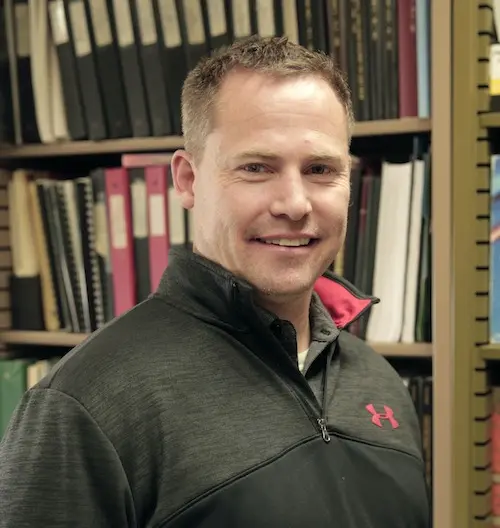Mark Anderson sees big opportunities for significantly boosting the efficiency with which power plants generate electricity.
In his research, he tackles energy-related challenges from a number of angles, and advances from his projects have the potential to increase efficiency in generating power in nuclear, solar and fossil energy. These efficiency gains could ultimately lower the cost of electricity.
 Mark Anderson
Mark Anderson
Anderson, who joined the mechanical engineering faculty as an assistant professor in January 2018, currently is co-leading a major research project focused on advanced compact heat exchangers for use in nuclear systems.
Because these advanced compact heat exchangers provide more efficient heat transfer than traditional heat exchangers, they could increase the performance and lower the cost of nuclear reactor systems. However, for the new heat exchangers to be approved for future use in nuclear systems, the industry and regulators need proof they’ll be able to operate safely in a nuclear setting.
With $5 million in funding from the U.S. Department of Energy, Anderson and his collaborators are studying how advanced compact heat exchangers might fail in a nuclear system. With this knowledge, their goal is to provide the safety assurances needed for the nuclear power industry to adopt them for use in advanced nuclear reactors.
In another research area, Anderson is investigating the supercritical carbon dioxide power cycle. Traditional power plants produce electricity by combusting fuel, which heats water into steam. The steam, in turn, drives a turbine that generates electricity. But the extraordinary properties of supercritical carbon dioxide—a fluid with qualities of both a liquid and a gas—make it an exciting prospect for replacing the steam turbine system with a closed-cycle gas turbine that uses supercritical carbon dioxide.
It’s a change that would dramatically increase power generation efficiency. “The supercritical carbon dioxide power cycle requires a lot of heat exchanges within the cycle, and so I conduct research on that as well as on the turbomachinery and other components involved in the cycle to investigate different ways to improve the overall efficiency,” Anderson says.
In addition, Anderson studies how to tune the power cycle for different energy applications, including nuclear, solar or fossil. He says the supercritical carbon dioxide cycle would also enable power plants that burn fossil fuels to reduce the carbon emissions they release into the atmosphere. That’s because this cycle is well suited for capturing the carbon dioxide that’s created from burning the fuel and feeding it back into the system, sequestering it or using for chemical processes.
In a related area of research, Anderson studies a variety of fluids involved in transferring the heat from the power plant to the supercritical carbon dioxide cycle. These fluids include molten salts and sodium, which Anderson researches using test loops at the Tantalus research facility he manages. He is interested in these liquids because they could allow power plants to operate safely at higher temperatures, which is important for increasing a power plant’s efficiency.
Liquid salts can also be used for energy storage—another active research area for Anderson. “When people think of energy storage, they typically think of a battery,” Anderson says. “But we can also store energy in the form of heat, and it turns out to be fairly effective.”
For example, concentrated solar power plants collect heat from sunlight to produce electricity, and this heat can be stored in liquid salt. Then, the liquid salt can be pumped through a heat exchanger to extract the energy when needed.
Anderson says this type of energy storage is particularly important for renewable energy sources like concentrated solar power because the energy generated varies widely based on how sunny (or not) it is on any given day. That’s a problem for the electrical grid, which relies on stable power to operate effectively.
“You either need backup power or stored energy to provide electricity when it’s needed,” Anderson says. “I’m investigating thermal energy storage associated with these power plants to make the grid more effective and also allow more renewables to come online.”
While Anderson is a new faculty member in the mechanical engineering department, he’s not new to the College of Engineering. After earning his PhD in mechanical engineering at UW-Madison in 1998, Anderson started working as a scientist in the UW-Madison Department of Nuclear Engineering and Engineering Physics. Over the years, he rose to the rank of engineering physics research professor.
Anderson says joining the mechanical engineering faculty was a natural next step as his interests and research have evolved over the years. “I had previously been doing mostly nuclear research, but the research has morphed more into mechanical engineering,” he says. “The liquid salts are of interest to the solar industry, and the fossil industry is interested in the supercritical carbon dioxide cycle, so I started to do work in more areas.”
He says he’s also excited about the opportunity to teach students in his new position.